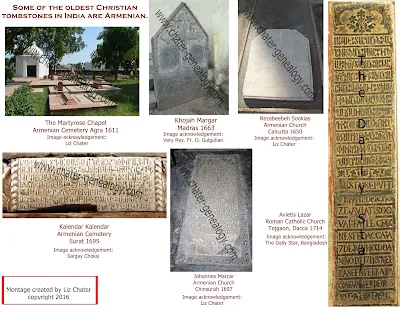This story is brought to you with the support of the
AGBU UK Trust.
AGBU UK Trust.
*NOTE:
The hyperlinks in square brackets [ ] do not work in this blog, please scroll
to the bottom to read the links.
Generally speaking, when one thinks of St. John’s Church Rangoon one normally thinks of the Armenian Church. Currently enjoying a renaissance in popularity, the Yangon St. John the Baptist Armenian church is breathing easier these days, thanks to the recent intervention of the Armenian Holy See to reclaim and revive it from years of stifled possession of an unauthorised non Armenian incumbent. Rescued in the nick of time, its beginnings, roots and history are once again proudly and rightly lauded by Armenians around the world. Its precious fabric now rests securely for future generations and visitors to worship in.
Generally speaking, when one thinks of St. John’s Church Rangoon one normally thinks of the Armenian Church. Currently enjoying a renaissance in popularity, the Yangon St. John the Baptist Armenian church is breathing easier these days, thanks to the recent intervention of the Armenian Holy See to reclaim and revive it from years of stifled possession of an unauthorised non Armenian incumbent. Rescued in the nick of time, its beginnings, roots and history are once again proudly and rightly lauded by Armenians around the world. Its precious fabric now rests securely for future generations and visitors to worship in.
But what of the other St. John’s Church of Yangon? No, it is
not Armenian, but it does have a significant Armenian association, and one that
is sadly forgotten today. Even the St. John's Catholic Church website cannot fully recite its own early years.
Time has diluted the importance of the Armenian connection. Let me try to revive it.
 |
| St. John’s Catholic Church Yangon. Built in extraordinarily
quick time, within a 20 month period. It was made possible by the generosity of a
Catholic Armenian of Rangoon, Gregory Avanis. Image courtesy of http://yangonarchitecture.tumblr.com/page/10 |
The basic foundations were dug after the end of the second
Burmese-Anglo war in 1853. Bishop Balma
had decided to make the city his permanent place of residence, and it was at
this time that he “laid down in the military cantonments, the
foundations of the church of St. John the Baptist.” This early development
was “left in an unfinished state until
the year 1857.[1]” Questionable as to whether it would ever
be built, it remained like this until a Catholic Armenian, Gregory Avanis came
to the rescue.
In his Will[2] he donated
the entire cost of the structure, bequeathing the sum
of Companys Rupees 20,000 and ensuring its completion.
Over the last few years, I have read hundreds, probably even
a few thousand pages of old Armenian Wills and Inventories in an attempt to
piece together many fragments of lost Armenian family history in India. The Will
of Gregory Avanis is written in the same vein as scores of others in Asia. He
could not have realised how his act of generosity would help build a church
that continues to stand today. He died
in Madras in April 1858, having declared his final wishes less than a month
before in Madras.
It seems his heart was in Rangoon.
Leaving a legacy such as this in a Will does not necessarily
mean the wishes of the testator would be fulfilled. It is fortunate that in
the book “An Outline of the History of
the Catholic Burmese Mission” by Reverend Bigandet he gave crucial details of the
re-commencement of the building process of the church.
“In February 1858, the corner stone of the church of Rangoon was laid
down amidst a great concourse of people. The ceremony was presided by the
Bishop, assisted by the Rev. P. Barbe, C. Paruza, C. Pacchiotti and V. Gabutti.
The band of the European Regiment enlivened the ceremony. M. Th. Chrestian laid
down the corner stone. During the rainy season, the work was interrupted, to
give time to the foundations to sit well in the ground.
The work resumed in the month of October, and carried on without
interruption. The church was blessed and, for the first time, opened for divine
service on the 3rd Sunday of Advent, of the year 1859. It was
erected solely at the expense of Mr. Gregory Avanis an Armenian, native of
Rangoon, who since the war of 1824 had migrated to Madras, where he died on the
2nd of April 1858 having just received the information that the work
of laying the foundation of the church had been begun.
He bequeathed the sum of 20,000 Rupees, for building the church, and a
similar sum in Company’s papers, with the injunction that the interest should
be used for repairing the church, and praying for the repose of his soul.”
Rev. Bigandet’s recollections are the perfect independent
proof and provenance that St. John’s Catholic Church, Rangoon was started by a
Bishop, completed by an Armenian and enjoyed by all who worship there.
After Gregory’s death a tablet was placed in his memory at
the St. Mary’s Roman Catholic Cathedral, Madras by his brother Stephen whose
own family continued to reside in Rangoon. The memorial inscription reads: “Sacred to the memory of Gregory Avanis,
Esq., aged 75 years. This tablet was erected by his affectionate brother
Stephen Avanis.[3]”
With a little digging, some patience and a lot of time this
is another small piece of forgotten Armenian family history brought back to
life.
For my earlier story on another Armenian who built a Catholic church you can find it here
“Catholic Armenians: Let’s Build a Church”.
Acknowledgements:
Image of St. John's Catholic Church, Yangon Architecture
Image of St. John's Catholic Church, Yangon Architecture
[1]
An Outline of the History of the
Catholic Burmese Mission From The Year 1720 to 1887. By Paul Ambroise Bigandet
[2]
The Will of Gregory Avanis.
British Library L/AG/34/29/258/7 1858.
[3]
List of Tombs and Monuments of
Europeans in the Madras District. P.55












